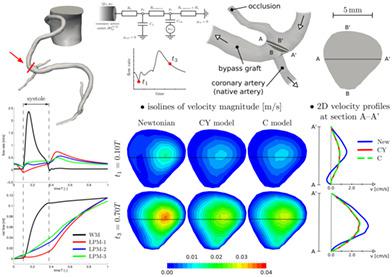当前位置:
X-MOL 学术
›
Int. J. Numer. Method. Biomed. Eng.
›
论文详情
Our official English website, www.x-mol.net, welcomes your feedback! (Note: you will need to create a separate account there.)
On the relevance of boundary conditions and viscosity models in blood flow simulations in patient‐specific aorto‐coronary bypass models
International Journal for Numerical Methods in Biomedical Engineering ( IF 2.1 ) Pub Date : 2021-01-19 , DOI: 10.1002/cnm.3439 Alena Jonášová 1, 2 , Jan Vimmr 1, 2
International Journal for Numerical Methods in Biomedical Engineering ( IF 2.1 ) Pub Date : 2021-01-19 , DOI: 10.1002/cnm.3439 Alena Jonášová 1, 2 , Jan Vimmr 1, 2
Affiliation

|
Physiologically realistic results are the aim of every blood flow simulation. This is not different in aorto‐coronary bypasses where the properties of the coronary circulation may significantly affect the relevance of the performed simulations. By considering three patient‐specific bypass geometries, the present article focuses on two aspects of the coronary blood flow – its phasic flow pattern and its behaviour affected by blood rheology. For the phasic flow property, a multiscale modelling approach is chosen as a means to assess the ability of five different types of coronary boundary conditions (mean arterial pressure, Windkessel model and three lumped parameter models) to attain realistic coronary haemodynamics. From the analysed variants of boundary conditions, the best option in terms of physiological characteristics and its potential for use in patient‐based simulations, is utilised to account for the effect of shear‐dependent viscosity on the resulting haemodynamics and wall shear stress stimulation. Aside from the Newtonian model, the blood rheology is approximated by two non‐Newtonian models in order to determine whether the choice of a viscosity model is important in simulations involving coronary circulation. A comprehensive analysis of obtained results demonstrated notable superiority of all lumped parameter models, especially in comparison to the constant outlet pressure, which regardless of bypass type gave overestimated and physiologically misleading results. In terms of rheology, it was noted that blood in undamaged coronary arteries behaves as a Newtonian fluid, whereas in vessels with atypical lumen geometry, such as that of anastomosis or stenosis, its shear‐thinning behaviour should not be ignored.
中文翻译:

关于边界条件和粘度模型在患者特定主动脉冠状动脉搭桥模型中血流模拟中的相关性
生理上真实的结果是每个血流模拟的目标。这在主动脉冠状动脉搭桥术中没有什么不同,其中冠状动脉循环的特性可能会显着影响所执行模拟的相关性。通过考虑三种特定于患者的旁路几何结构,本文重点关注冠状动脉血流的两个方面 - 其相流模式及其受血液流变学影响的行为。对于相流特性,选择多尺度建模方法作为评估五种不同类型冠状动脉边界条件(平均动脉压、Windkessel 模型和三个集总参数模型)获得真实冠状动脉血流动力学的能力的手段。从分析的边界条件变体中,就生理特征及其在基于患者的模拟中使用的潜力而言,最佳选择用于解释剪切依赖性粘度对由此产生的血液动力学和壁剪切应力刺激的影响。除了牛顿模型外,血液流变学由两个非牛顿模型近似,以确定粘度模型的选择在涉及冠状动脉循环的模拟中是否重要。对所得结果的综合分析表明,所有集总参数模型都具有显着优势,特别是与恒定出口压力相比,无论旁路类型如何,都会给出高估和生理上误导的结果。在流变学方面,有人指出未受损冠状动脉中的血液表现为牛顿流体,
更新日期:2021-01-19
中文翻译:

关于边界条件和粘度模型在患者特定主动脉冠状动脉搭桥模型中血流模拟中的相关性
生理上真实的结果是每个血流模拟的目标。这在主动脉冠状动脉搭桥术中没有什么不同,其中冠状动脉循环的特性可能会显着影响所执行模拟的相关性。通过考虑三种特定于患者的旁路几何结构,本文重点关注冠状动脉血流的两个方面 - 其相流模式及其受血液流变学影响的行为。对于相流特性,选择多尺度建模方法作为评估五种不同类型冠状动脉边界条件(平均动脉压、Windkessel 模型和三个集总参数模型)获得真实冠状动脉血流动力学的能力的手段。从分析的边界条件变体中,就生理特征及其在基于患者的模拟中使用的潜力而言,最佳选择用于解释剪切依赖性粘度对由此产生的血液动力学和壁剪切应力刺激的影响。除了牛顿模型外,血液流变学由两个非牛顿模型近似,以确定粘度模型的选择在涉及冠状动脉循环的模拟中是否重要。对所得结果的综合分析表明,所有集总参数模型都具有显着优势,特别是与恒定出口压力相比,无论旁路类型如何,都会给出高估和生理上误导的结果。在流变学方面,有人指出未受损冠状动脉中的血液表现为牛顿流体,



























 京公网安备 11010802027423号
京公网安备 11010802027423号